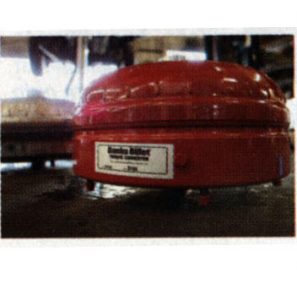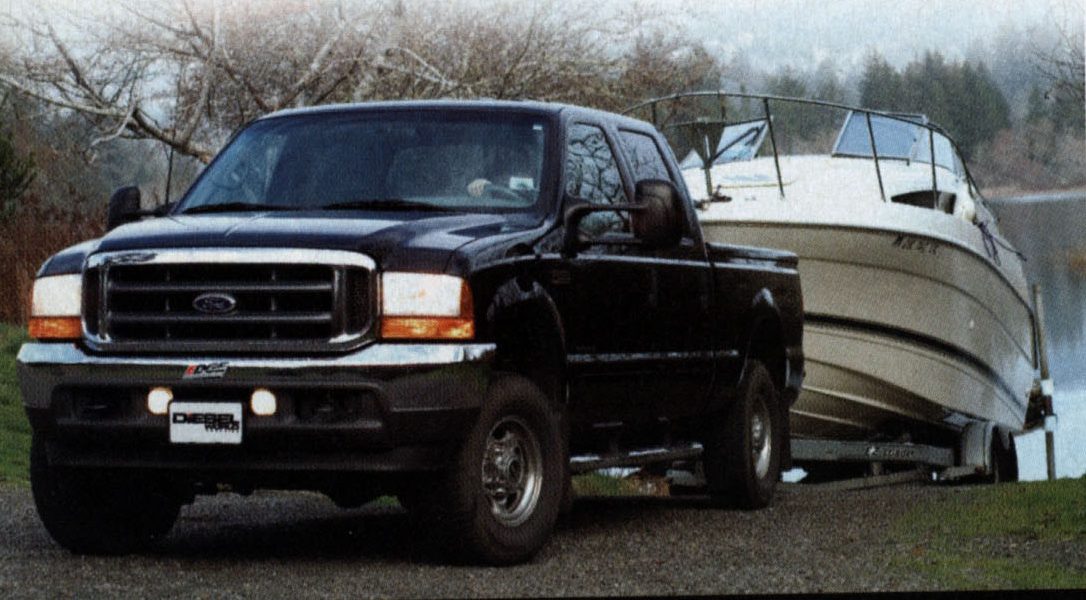Transfer of Power
Diesel World Spring 2006
Banks Billet Torque Converter Tough Enough for Big Diesel Power.
As diesel power is increased through performance upgrades, it is often the torque converter that is not up to the task. Incidents of torque converter failure are further increased as hauling and towing loads get heavier.
A torque converter’s job is to provide a fluid coupling that allows the engine to continue running when the vehicle is stopped in gear. Because the inverter and turbine that push and receive the fluid can never achieve a solid lockup, most torque converters also have clutches that engage to achieve a mechanical connection between the engine and the transmission. Lower quality clutch compounds in stock converters work fine when the engine is stock or loads are light. But add more horsepower more torque and/or a heavy load and clutches start slipping under the extra strain. This slipping causes friction that produces heat that the stock converter cover is ill equipped to handle.
According to John Domaschofsky of Dan Judy Automotive (Salem, OR 50l.362.5830), when the clutches start burning there’s so much heat generated it turns the outside of the torque converter bright blue.” The heat also causes the torque converter housings to deform or balloon. This ballooning causes looser tolerances, which, inturn, create higher stall speeds that produce even more heat. A deformed torque converter housing also reduces the clutch surface area causing more slip, more heat and more debris. Debris in the transmission fluid is from the heat damaging the seals and plastic pieces in the transmission, says Domaschofsky, who has spent a lot of years repairing automatic transmissions and replacing torque converters. Heat also causes fluids to degrade.
The transmission and the torque converter share fluid,” elaborates Domaschofsky . When the torque converter starts to fail it will produce material that will contaminate the transmission. The fluid comes out of the torque converter and into the cooling system. As the torque converter and transmission begin their downward death spiral, material can get caught and plug the cooling system. This of course, causes even more heat build-up.” Fluid that ls retuning to the transmission from the cooling system gets dumped onto the planetary gears. Any material that happens to be in the fluid goes directly onto the gear surfaces. This is why its not a good idea to keep running a damaged or inadequate torque converter. ln all the years l`ve been in the business, I`ve never seen a torque converter failure that has not caused damage to the transmission, says Domaschofsky.
BILLET Solution
Gale Banks Engineering, which is responsible for their share of the aftermarket diesel power out there on the road, developed a special high-performance billet torque converter that can handle the new-found power. We tested Banks’ Billet Torque Converter (P/n #7252i; $995 plus $250 core charge) in our F-250 Super Duty with a 7.3 liter Power Stroke, which has been tuned for power by addition of electronic and exhaust upgrades. Along with the new torque converter, we installed a Banks TransCommand unit to beef up clutch line pressures.
The portion of the stock torque convener that is bolted to the engine flexplate is a stamped steel housing with welded-on tabs, which can deflect or distort the housing under sustained high loads. This distortion usually causes high spots on the machined metal surface that ls engaged by the lockup clutch. With less metal surface contacting the clutch surface, clutch slippage, dust and heat multiply ln a vicious cycle. The Banks part addresses these issues by using a one piece billet cover that ls precision machined from a solid place of forged steel billet to maintain its structural integrity under extreme heat and mechanical stress. This billet construction reduces flex, thereby retaining clutch contact surface even under heavy loads. This means quicker, surer lock-up and less slippage, which, in tum, helps prevent heat, wear and fluid contamination.
Other features of the Banks converter that make it tougher also improve performance. For example, stock inverter and turbine blades are held ln place by small tabs that protrude through a slot. The tabs are bent over to hold them ln place. These fins can become loose and diminish in efficiency when subjected to high loads. The fins in a Banks torque converter are Furnace-brazed in place to prevent loosening caused by high power and weight loads. Furnace brazing creates a much stronger bond to withstand the rigors of heat and fluid pressure. The Banks dual-disc clutch maximizes surface area to reduce slippage under the combination of high torque and heavy load. Carbon-ceramic clutch materials. Which improve on the stock cellulose based paper material, mean less clutch material ls being ground off of the plates and into the automatic transmission fluid.
Shop Time
Upgrading to the new banks billet torque convener could be installed by a skilled backyard mechanic in about a day The manual that comes with lt is pretty detailed, but the recommended tools list has some specialized items like transmission hoists, flywheel rotating tool and a torque converter holding tool. We started our project by installing a transmission oil temperature gauge, because fluid temperatures are one of the best indicators of what is going on with the torque converter. In fact, a transmission oil temperature gauge ls a good idea for anyone who pulls heavy loads and/or has significantly increased the power output of their tow vehicle. We installed the sensor for the temperature gauge in the line near where the fluid leaves the transmission before going to the cooler. This location gives a better read on torque converter activity instead of just how well your transmission cooler ls working. We monitored transmission temperatures under several conditions including town driving, highway cruising and acceleration runs. As expected, trans temps went up when each torque converter was working the hardest in stop-and-go traffic and under heavy acceleration.

The banks TransCommand transmission module comes with a bypass plug that can be inserted to return the vehicle to factory transmission control functions.

The Banks Billet torque converter is designed to withstand the stresses of high torque diesel engines. A detailed eight-page installation manual is provided withe the torque converter, but we followed Banks advice and had it done by a professional shop.

Damaged teeth on the ring gear required replacement of the flexplate. This is a simple job while the transmission is off for the torque converter install, but its an expensive repair if done separately.

While the Banks Billet Torque Converter doesn’t look much different than the stock version on the outside, its tougher steel, heavier clutches and tighter tolerances make a big difference.

The blue steel seen on this stock torque converter is normal from the welding process when it was built. However, bright blue or blackened steel where the torque converter attaches to the flexplate (flywheel) indicates damaged and would call for a careful inspection of the transmission.

The Banks Billet Torque Converter was beefed up to handle higher power and heavier loads. In addition to stronger materials in the covers and clutch surfaces, other internals have been fine tuned to get things moving at lower rpm to better match the diesel power band.


